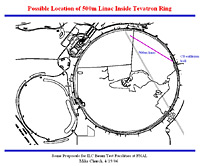 |
|||||||||||
|
|||||||||||
|
|||||||||||
|
Before the International Linear Collider can be built, physicists and engineers must prove that the proposed baseline design will achieve the desired physics, requiring testing and R&D at laboratories and institutions around the world. As part of this process, Fermilab's Mike Church recently shared with attendees, at a weekly ILC R&D meeting, one possible proposal for ILC Test Beam Facilities that would utilize the lab's already existing infrastructure. In an early stage of development and not yet endorsed by Fermilab management, the proposal will continue to be evaluated and reviewed not only by the lab but also by the Global Design Effort and the Department of Energy. "This is a work in progress," Church said. "We haven't thought too seriously about cost, location or a timeline yet. The tiered proposal allows you to make more rational decisions about what you're getting." Put together by a team of scientists in March 2006, Church outlined a five-tiered plan in which each facility requires the previous one to be developed. With parts of the proposal already in action at Fermilab, the 5-tiered proposal is as follows:
Emphasizing that this proposal is not final, Church discussed the number of questions that surround building test facilities at Fermilab. Whether the test facility should be located underground, for example, to study such issues as ground motion, temperature and humidity control is one of the questions that scientists will continue to assess. Other proposals for similar facilities are also being explored at DESY in Germany, at Cornell University in the U.S. and at KEK in Japan. As important facilities for conducting the necessary R&D for the ILC, they may also serve an important role in education. "Training for staff and students is important," Church said. "A 5 GeV facility will really serve as a learning facility."-- Elizabeth Clements |
|||||||||||
| © International Linear Collider |
